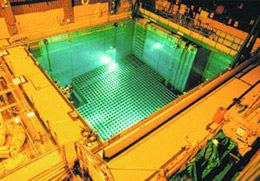This involves storing spent fuel rods under at
least 20 feet of water. The water provides adequate shieldingfrom
the radiation for anyone near the pool. It also provides
cooling for the fuel. The decay of fission
products produces heat in the fuel
(called decay heat) even after the
reactor has ceased operation. This heat necessitates the storage
of spent
fuel in a pool to allow for heat removal by water.
The rods are moved into the water pools from the reactor along the
bottom of water canals, so that the spent fuel is always
shielded to protect workers. The quantity of fuel that can be
stored is constrained by the size of the pool.
(Source: US NRC)
